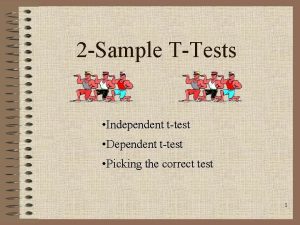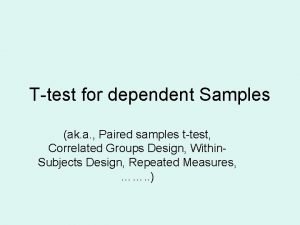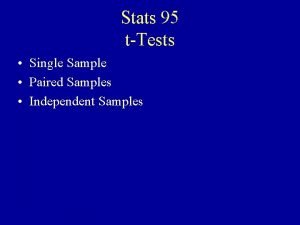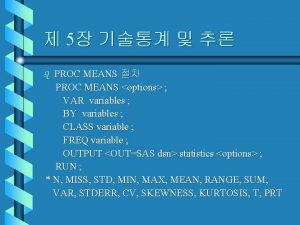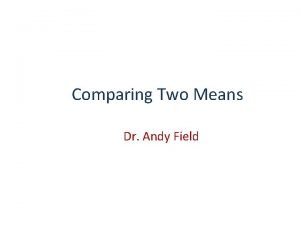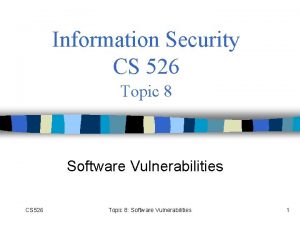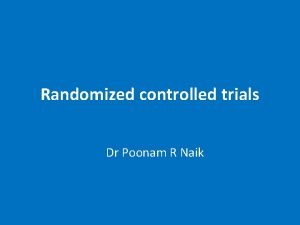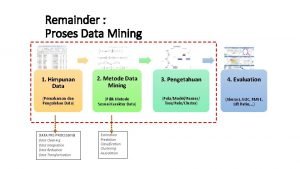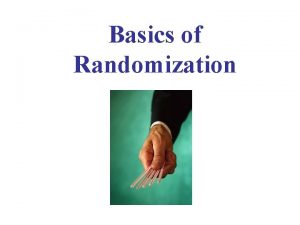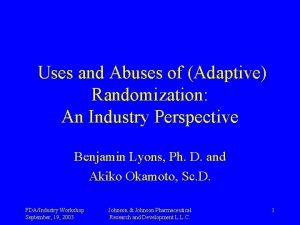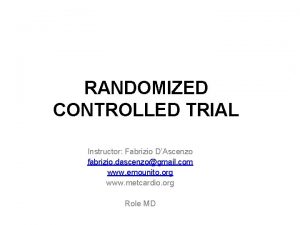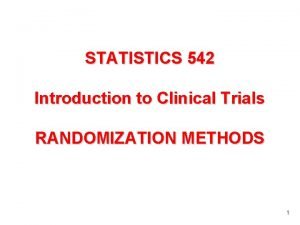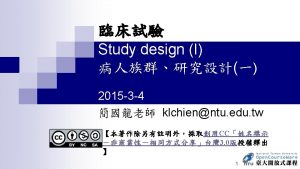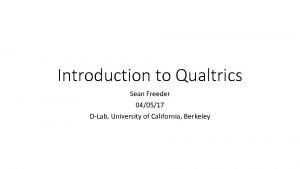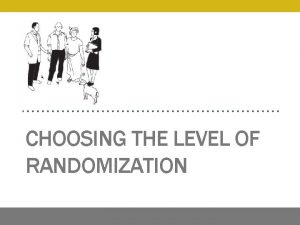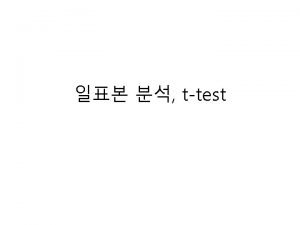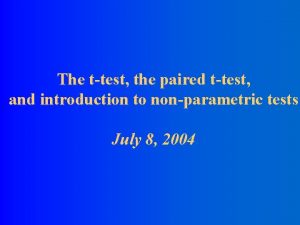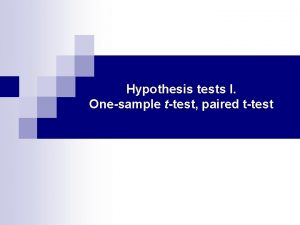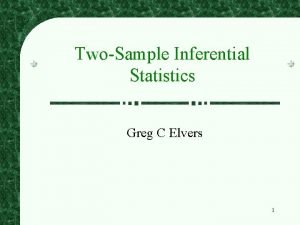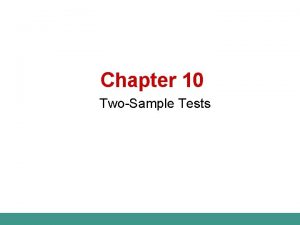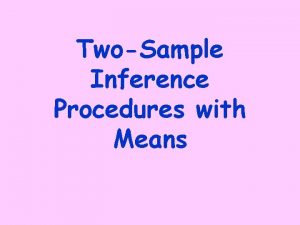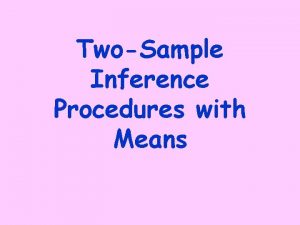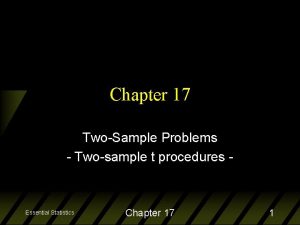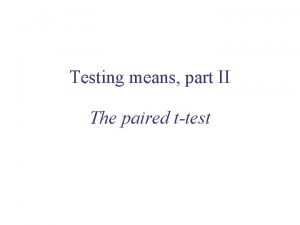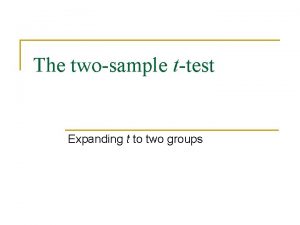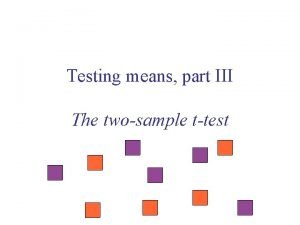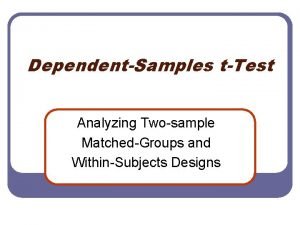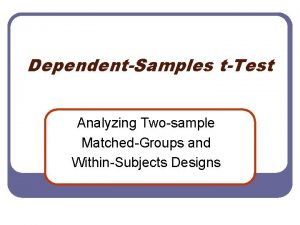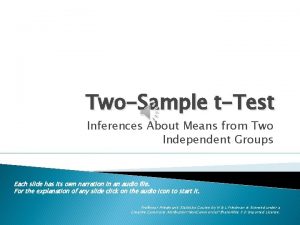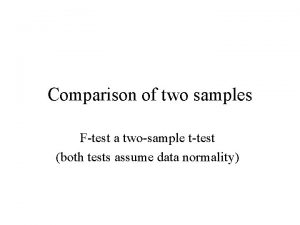Outline Randomization issues Twosample ttest vs paired ttest





![RGList class > attributes(Limmadata. C) $names [1] "R" "G" "Rb" "Gb" "weights" "targets" "genes" RGList class > attributes(Limmadata. C) $names [1] "R" "G" "Rb" "Gb" "weights" "targets" "genes"](https://slidetodoc.com/presentation_image_h2/d223c439aadc52844f4c14ddeed379a3/image-6.jpg)
![RGList class > Limmadata. C$R[1: 3, ] 51 -C 1 -3 -vs-W 1 -5 RGList class > Limmadata. C$R[1: 3, ] 51 -C 1 -3 -vs-W 1 -5](https://slidetodoc.com/presentation_image_h2/d223c439aadc52844f4c14ddeed379a3/image-7.jpg)
![RGList class Limmadata. C$genes$Status<-control. Status(spottypes, Limmadata. C) Limmadata. C$weights[Limmadata. C$genes$ID=="Blank"]<-0 Limmadata. C$printer<-get. Layout(Limmadata. C$genes) RGList class Limmadata. C$genes$Status<-control. Status(spottypes, Limmadata. C) Limmadata. C$weights[Limmadata. C$genes$ID=="Blank"]<-0 Limmadata. C$printer<-get. Layout(Limmadata. C$genes)](https://slidetodoc.com/presentation_image_h2/d223c439aadc52844f4c14ddeed379a3/image-8.jpg)


![limma > NBLimmadata. C<-background. Correct(Limmadata. C, method="none") > attributes(NBLimmadata. C) $names [1] "R" "G" limma > NBLimmadata. C<-background. Correct(Limmadata. C, method="none") > attributes(NBLimmadata. C) $names [1] "R" "G"](https://slidetodoc.com/presentation_image_h2/d223c439aadc52844f4c14ddeed379a3/image-11.jpg)








![Paired t-test using limma > mean(c(1, -1, 1, -1)*NNBLimmadata. C$M[2, ]) [1] -0. 03068036 Paired t-test using limma > mean(c(1, -1, 1, -1)*NNBLimmadata. C$M[2, ]) [1] -0. 03068036](https://slidetodoc.com/presentation_image_h2/d223c439aadc52844f4c14ddeed379a3/image-20.jpg)
![Paired t-test using limma > mean(c(1, -1, 1, -1)*NNBLimmadata. C$M[1, ]) [1] 0. 1425021 Paired t-test using limma > mean(c(1, -1, 1, -1)*NNBLimmadata. C$M[1, ]) [1] 0. 1425021](https://slidetodoc.com/presentation_image_h2/d223c439aadc52844f4c14ddeed379a3/image-21.jpg)


- Slides: 23

Outline • Randomization issues • Two-sample t-test vs paired t-test • I made a mistake in creating the dataset, so previous analyses will not be comparable with new ones • Issues of the background subtraction • Limma as the general tool for analyzing microarray data 1 -18 -2005 1

limma. . . is a package for the analysis of microarray data, especially the use of linear models for analyzing designed experiments and the assessment of differential expression. • Specially constructed data objects to represent various aspects of microarray data • Specially constructed "object methods" for importing, normalizing, displaying and analyzing microarray data • All objects and methods are transparent • All objects can be accessed and modified outside of limma • Unique in the implementation of the empirical Bayes procedure for identifying differentially expressed genes by "borrowing" information from different genes (everything so far has been gene by gene) 1 -18 -2005 2

Measurement Error Model With Additive Background Foreground (F) Old Model Background (B) New Model • There are other models for accounting for the background signal • Simple subtraction of the background intensities often introduces additional variability in the observed signal • The problem is in the fact that we use a single-observation estimate for B • With this in mind, various strategies have been proposed to pool background information from more than one spot to estimate B 1 -18 -2005 3

limma Data to import: http: //eh 3. uc. edu/data/51 -C 1 -3 -vs-W 1 -5. gpr File descriptions: http: //eh 3. uc. edu/data/WTargets. txt Spot descriptions: http: //eh 3. uc. edu/data/WSpot. Types. txt Importing data: source("http: //eh 3. uc. edu/Limma. Data. Import. R") 1 -18 -2005 4

limma library(limma) data. directory<-"http: //eh 3. uc. edu/data/" targets<-read. Targets("http: //eh 3. uc. edu/data/WTargets. txt") spottypes<-read. Spot. Types("http: //eh 3. uc. edu/data/WSpot. Types. txt") Limmadata. C<-read. maimages(files=targets$File. Name, source="genepix", path = data. directory, columns=list(Gf = "F 532 Median", Gb ="B 532 Median", Rf = "F 635 Median", Rb = "B 635 Median"), annotation=c("Name", "ID", "Block", "Row", "Column"), wt. fun=wtflags(0)) 1 -18 -2005 5
![RGList class attributesLimmadata C names 1 R G Rb Gb weights targets genes RGList class > attributes(Limmadata. C) $names [1] "R" "G" "Rb" "Gb" "weights" "targets" "genes"](https://slidetodoc.com/presentation_image_h2/d223c439aadc52844f4c14ddeed379a3/image-6.jpg)
RGList class > attributes(Limmadata. C) $names [1] "R" "G" "Rb" "Gb" "weights" "targets" "genes" $class [1] "RGList" attr(, "package") [1] "limma" 1 -18 -2005 6
![RGList class Limmadata CR1 3 51 C 1 3 vsW 1 5 RGList class > Limmadata. C$R[1: 3, ] 51 -C 1 -3 -vs-W 1 -5](https://slidetodoc.com/presentation_image_h2/d223c439aadc52844f4c14ddeed379a3/image-7.jpg)
RGList class > Limmadata. C$R[1: 3, ] 51 -C 1 -3 -vs-W 1 -5 60 -W 2 -3 -vs-C 2 -5 72 -C 3 -3 -vs-W 3 -5 79 -W 4 -3 -vs-C 4 -5 82 -C 5 -3 -vs-W 5 -5 97 -W 6 -3 -vs-C 6 -5 [1, ] 85 57 91 71 [2, ] 358 1102 2394 1685 [3, ] 168 376 620 67 111 575 882 206 293 > Limmadata. C$Rb[1: 3, ] 51 -C 1 -3 -vs-W 1 -5 60 -W 2 -3 -vs-C 2 -5 72 -C 3 -3 -vs-W 3 -5 79 -W 4 -3 -vs-C 4 -5 82 -C 5 -3 -vs-W 5 -5 97 -W 6 -3 -vs-C 6 -5 [1, ] 81 55 65 51 52 72 [2, ] 81 56 65 51 51 72 [3, ] 82 57 64 50 48 69 > Limmadata. C$genes[1, ] Name ID Block Row Column 1 no name Rn 30000100 1 -18 -2005 1 1 1 7
![RGList class Limmadata CgenesStatuscontrol Statusspottypes Limmadata C Limmadata CweightsLimmadata CgenesIDBlank0 Limmadata Cprinterget LayoutLimmadata Cgenes RGList class Limmadata. C$genes$Status<-control. Status(spottypes, Limmadata. C) Limmadata. C$weights[Limmadata. C$genes$ID=="Blank"]<-0 Limmadata. C$printer<-get. Layout(Limmadata. C$genes)](https://slidetodoc.com/presentation_image_h2/d223c439aadc52844f4c14ddeed379a3/image-8.jpg)
RGList class Limmadata. C$genes$Status<-control. Status(spottypes, Limmadata. C) Limmadata. C$weights[Limmadata. C$genes$ID=="Blank"]<-0 Limmadata. C$printer<-get. Layout(Limmadata. C$genes) > attributes(Limmadata. C) $names [1] "R" "G" "Rb" "Gb" "weights" "targets" "genes" "printer" $class [1] "RGList" attr(, "package") [1] "limma" > Limmadata. C$genes[1, ] Name ID Block Row Column Status 1 no name Rn 30000100 1 -18 -2005 1 1 1 c. DNA 8

Plotting data in a RGList object > plot. MA(Limmadata. C, array=1, xlim=c(-1, 16), ylim=c(-3, 8)) 1 -18 -2005 9

limma • Plot. MA automatically subtracts the background intensities before plotting data • Does not plot data with weight 0 • If you want to plot all data or the data without subtracting background, you need to do a little work • source("http: //eh 3. uc. edu/Background. Effects. R") 1 -18 -2005 10
![limma NBLimmadata Cbackground CorrectLimmadata C methodnone attributesNBLimmadata C names 1 R G limma > NBLimmadata. C<-background. Correct(Limmadata. C, method="none") > attributes(NBLimmadata. C) $names [1] "R" "G"](https://slidetodoc.com/presentation_image_h2/d223c439aadc52844f4c14ddeed379a3/image-11.jpg)
limma > NBLimmadata. C<-background. Correct(Limmadata. C, method="none") > attributes(NBLimmadata. C) $names [1] "R" "G" "weights" "targets" "genes" "printer" $class [1] "RGList" attr(, "package") [1] "limma" • Note that background measurements are gone 1 -18 -2005 11

Scatter with and without background subtraction • Background subtracted data is more spread • More data points without background subtractions 1 -18 -2005 12

Plotting all data points • Want to plot data points with weight 0 as well • Create datasets with and without subtracting background and set all weights to 1 Spots. Per. Array<-dim(Limmadata. C$R)[1] Narrays<-dim(Limmadata. C$R)[2] Limmadata<-Limmadata. C Limmadata$weights[1: Spots. Per. Array, 1: Narrays]<-1 NBLimmadata<-NBLimmadata. C NBLimmadata$weights[1: Spots. Per. Array, 1: Narrays]<-1 1 -18 -2005 13

Plotting all data points All data Zero-weight data removed Background Subtracted Raw 1 -18 -2005 14

Which one to use? • Removing points with the weight zero seems reasonable • Subtracting background costs us some data points even if one channel is above background since differences of log-transformed measurements are used only • Subtracting background seems to increase the variability, but it is unclear how would this affect results • For now proceed without background subtraction, but compare results at the end • Exploring other proposed background-adjustment methods also seems like a good idea 1 -18 -2005 15

Data Analysis Loess normalization source("eh 3. uc. edu/Limma. Loess. R") > NNBLimmadata. C<-normalize. Within. Arrays(NBLimmadata. C, method="loess") > attributes(NNBLimmadata. C) $names [1] "weights" "targets" "genes" "printer" "M" "A" $class [1] "MAList" attr(, "package") [1] "limma" 1 -18 -2005 16

Loess-normalized data 1 -18 -2005 17

Paired t-test using limma source("http: //eh 3. uc. edu/Limma. TTest. R") > design<-model. Matrix(targets, ref="C") Found unique target names: CW > design W 51 -C 1 -3 -vs-W 1 -5 1 60 -W 2 -3 -vs-C 2 -5 -1 72 -C 3 -3 -vs-W 3 -5 1 79 -W 4 -3 -vs-C 4 -5 -1 82 -C 5 -3 -vs-W 5 -5 1 97 -W 6 -3 -vs-C 6 -5 -1 1 -18 -2005 18

Paired t-test using limma > Limma. PTT<-lm. Fit(MA, design) Error in. class 1(object) : Object "MA" not found > Limma. PTT<-lm. Fit(NNBLimmadata. C, design) > > attributes(Limma. PTT) $names [1] "coefficients" "stdev. unscaled" "sigma" [5] "cov. coefficients" "pivot" [9] "genes" "method" "df. residual" "design" "Amean" $class [1] "MArray. LM" attr(, "package") [1] "limma" 1 -18 -2005 19
![Paired ttest using limma meanc1 1 1 1NNBLimmadata CM2 1 0 03068036 Paired t-test using limma > mean(c(1, -1, 1, -1)*NNBLimmadata. C$M[2, ]) [1] -0. 03068036](https://slidetodoc.com/presentation_image_h2/d223c439aadc52844f4c14ddeed379a3/image-20.jpg)
Paired t-test using limma > mean(c(1, -1, 1, -1)*NNBLimmadata. C$M[2, ]) [1] -0. 03068036 > var(c(1, -1, 1, -1)*NNBLimmadata. C$M[2, ])^0. 5 [1] 0. 3176068 > 1/(6^0. 5) [1] 0. 4082483 > mean(c(1, -1, 1, -1)*NNBLimmadata. C$M[2, ])/((var(c(1, -1, 1, -1)*NNBLimmadata. C$M[2, ])^0. 5)*(1/(6^0. 5))) [1] -0. 2366172 > > Limma. PTT$coefficients[2] [1] -0. 03068036 > Limma. PTT$stdev. unscaled[2] [1] 0. 4082483 > Limma. PTT$sigma[2] [1] 0. 3176068 > Limma. PTT$coefficients[2]/(Limma. PTT$sigma[2]*Limma. PTT$stdev. unscaled[2]) [1] -0. 2366172 1 -18 -2005 20
![Paired ttest using limma meanc1 1 1 1NNBLimmadata CM1 1 0 1425021 Paired t-test using limma > mean(c(1, -1, 1, -1)*NNBLimmadata. C$M[1, ]) [1] 0. 1425021](https://slidetodoc.com/presentation_image_h2/d223c439aadc52844f4c14ddeed379a3/image-21.jpg)
Paired t-test using limma > mean(c(1, -1, 1, -1)*NNBLimmadata. C$M[1, ]) [1] 0. 1425021 > var(c(1, -1, 1, -1)*NNBLimmadata. C$M[1, ])^0. 5 [1] 0. 2395690 > 1/(6^0. 5) [1] 0. 4082483 > mean(c(1, -1, 1, -1)*NNBLimmadata. C$M[1, ])/((var(c(1, -1, 1, -1)*NNBLimmadata. C$M[1, ])^0. 5)*(1/(6^0. 5))) [1] 1. 457023 > > Limma. PTT$coefficients[1] 0. 1875361 > Limma. PTT$stdev. unscaled[1] 0. 5 > Limma. PTT$sigma[1] 0. 2831248 > Limma. PTT$coefficients[1]/(Limma. PTT$sigma[1]*Limma. PTT$stdev. unscaled[1]) [1] 1. 324760 > NNBLimmadata. C$weights[1, ] 51 -C 1 -3 -vs-W 1 -5 60 -W 2 -3 -vs-C 2 -5 72 -C 3 -3 -vs-W 3 -5 79 -W 4 -3 -vs-C 4 -5 82 -C 5 -3 -vs-W 5 -5 97 -W 6 -3 -vs-C 6 -5 0 1 -18 -2005 0 1 1 21

Paired t-test using limma > dfp<-Limma. PTT$df. residuals>0 > Limma. PTT$Limma. TStat<-Limma. PTT$coefficients/(Limma. PTT$sigma*Limma. PTT$stdev. unscaled) > Limma. PTT$Limma. TPvalue<-rep(NA, Spots. Per. Array) > Limma. PTT$Limma. TPvalue[dfp]<-2*pt(Limma. PTT$Limma. TStat[dfp], Limma. PTT$df. residual[dfp], lower. tail =FALSE) > attributes(Limma. PTT) $names [1] "coefficients" "stdev. unscaled" "sigma" [5] "cov. coefficients" "pivot" [9] "genes" "Amean" "method" "Limma. TStat" "df. residual" "design" "Limma. TPvalue" $class [1] "MArray. LM" attr(, "package") [1] "limma" 1 -18 -2005 22

limma so far • Facilitates easy data import and normalization • Keeps track of "bad" spots • To run the basic t-test, it takes a bit of additional work • If we were to use the empirical Bayes statistics as implemented in limma, it would be even easier • Empirical Bayes is generally BETTER than simple t-test • Will talk about this type of analysis next week • Limma also allows fitting models with multiple factors which we will also talk about next week • Next time – multiple hypothesis testing and p-value adjustments 1 -18 -2005 23
 Ttest ind
Ttest ind Graphpad ttest
Graphpad ttest T test for dependent samples formula
T test for dependent samples formula Varianzanalyse
Varianzanalyse Paired t test vs unpaired
Paired t test vs unpaired Proc ttest
Proc ttest Between subjects design vs within
Between subjects design vs within Block randomization example
Block randomization example Address space layout randomization
Address space layout randomization Poonam naik
Poonam naik Randomization based on remainder
Randomization based on remainder Types of randomization
Types of randomization Interactive voice response system randomization
Interactive voice response system randomization Forced randomization
Forced randomization Stratified randomization
Stratified randomization Redcap randomization module
Redcap randomization module Randomization in statistics
Randomization in statistics Blocked random assignment
Blocked random assignment Qualtrics advanced randomization
Qualtrics advanced randomization Level of randomization
Level of randomization Redcap randomization module
Redcap randomization module Enduring issues essay sample
Enduring issues essay sample Enduring issues essay examples
Enduring issues essay examples How to write enduring issues essay
How to write enduring issues essay
